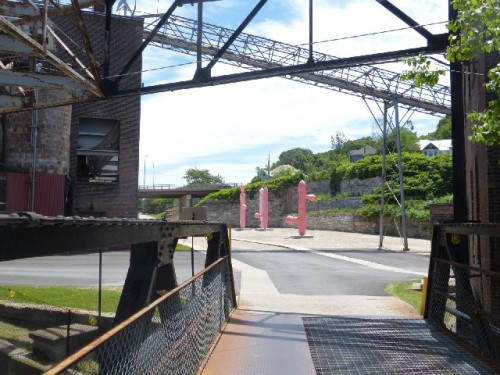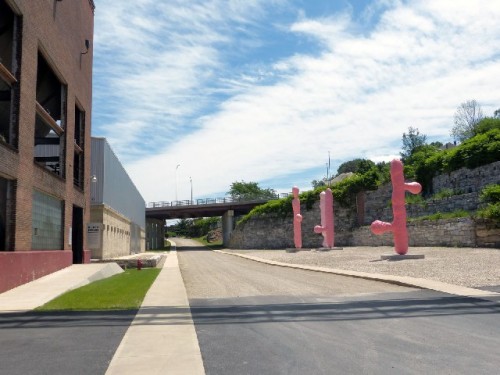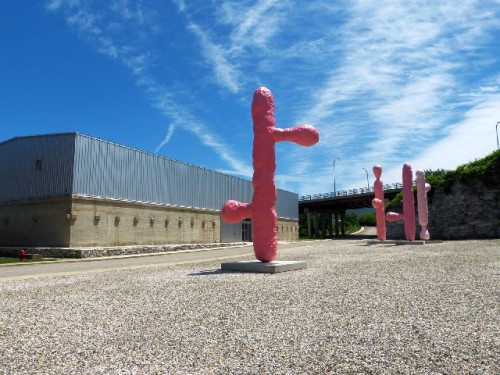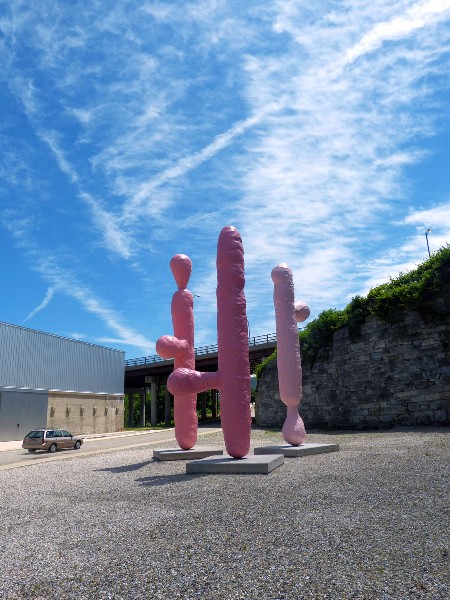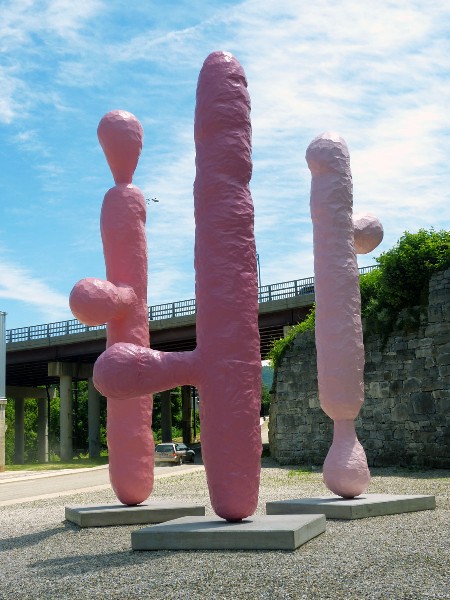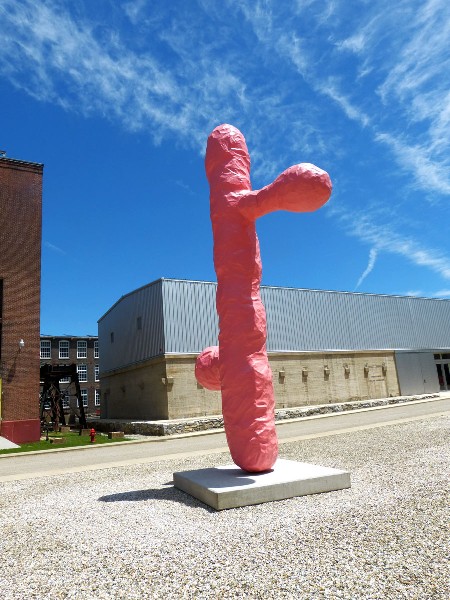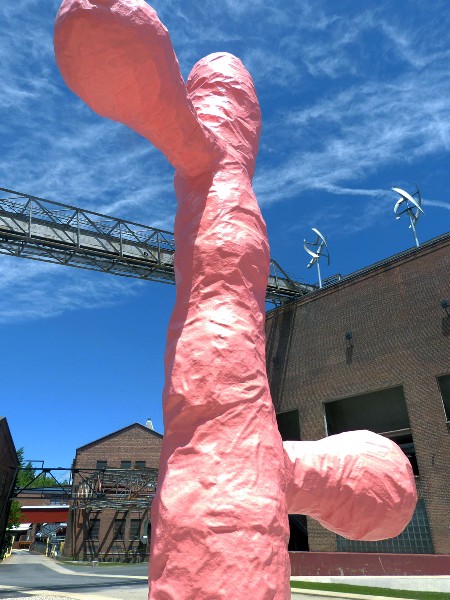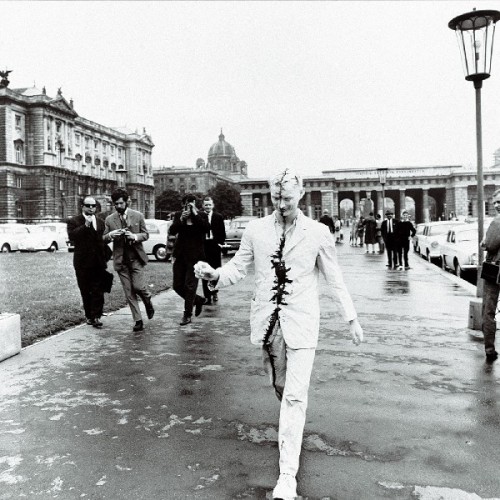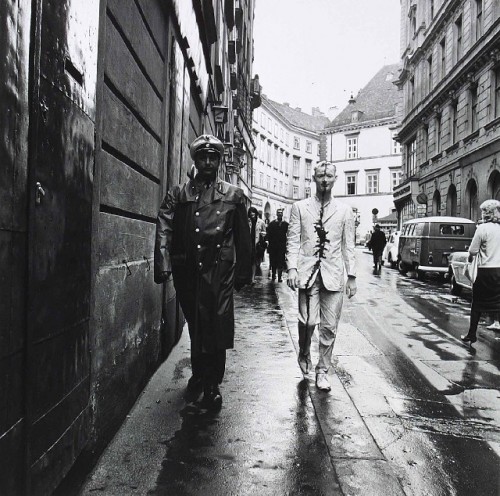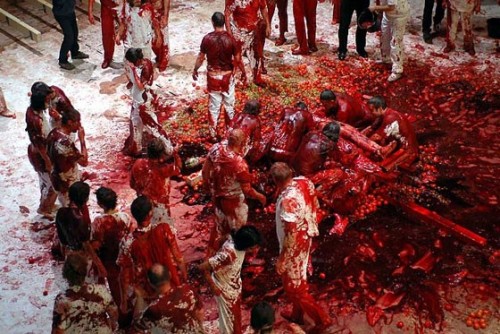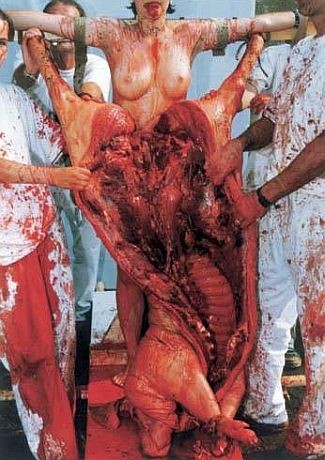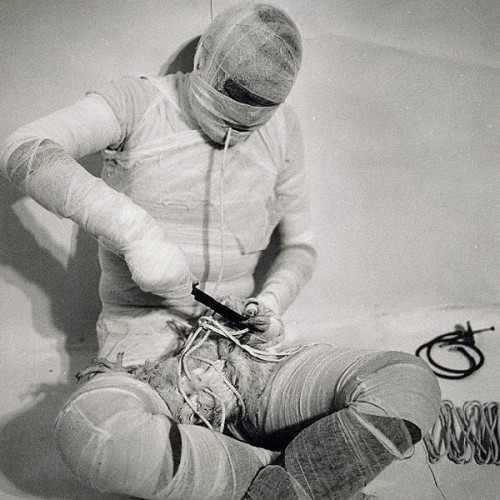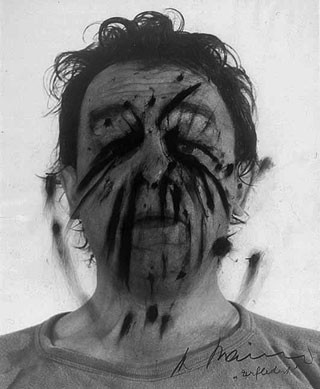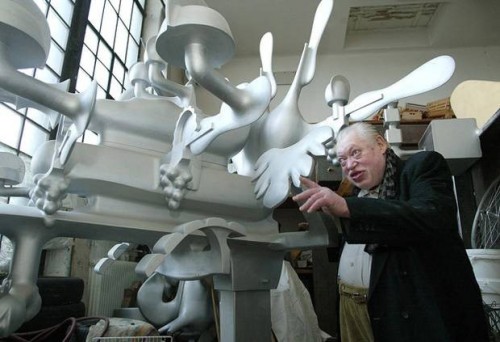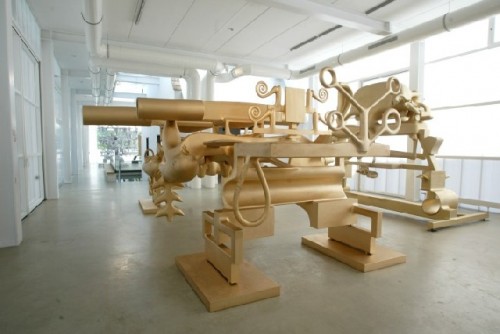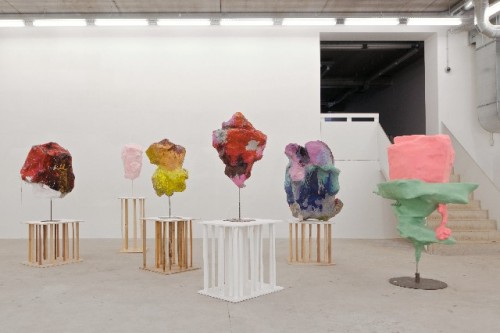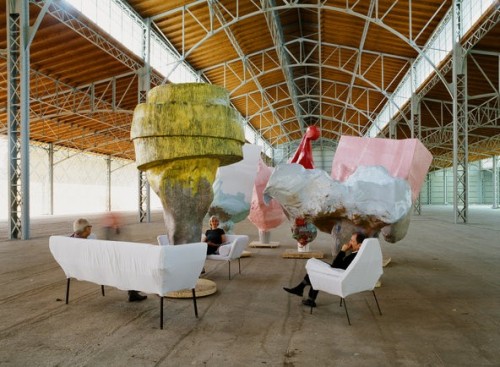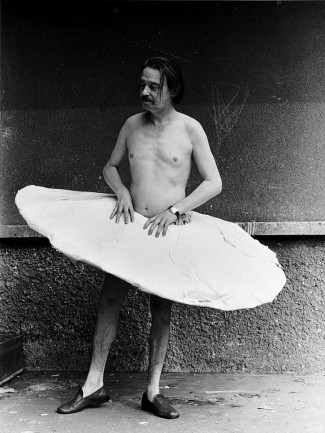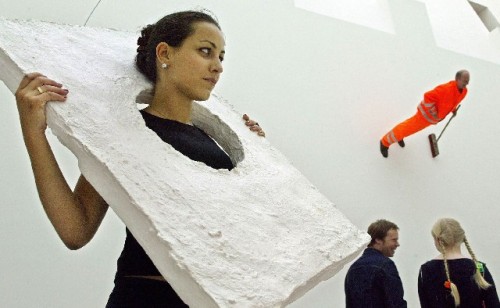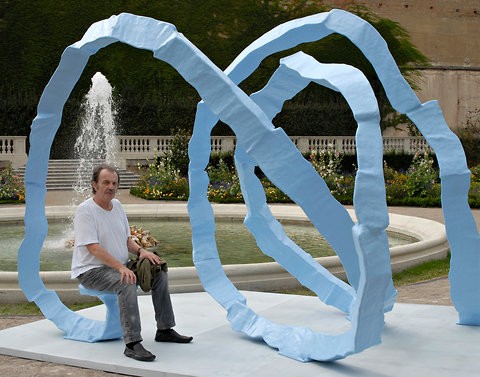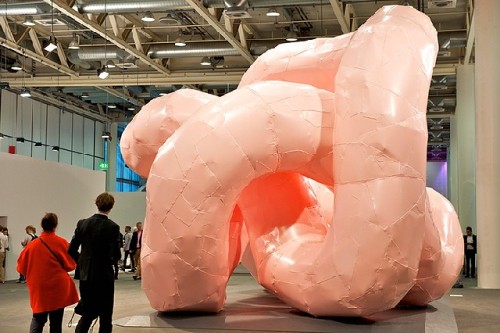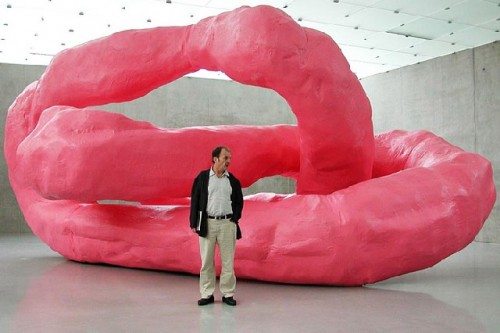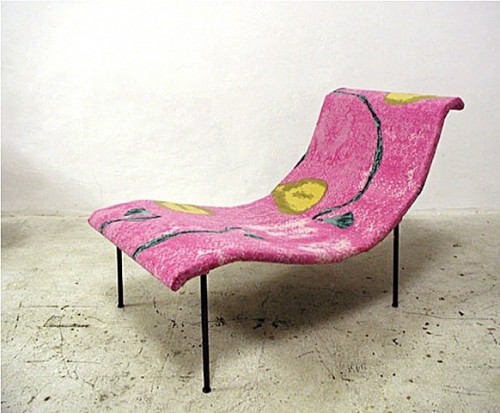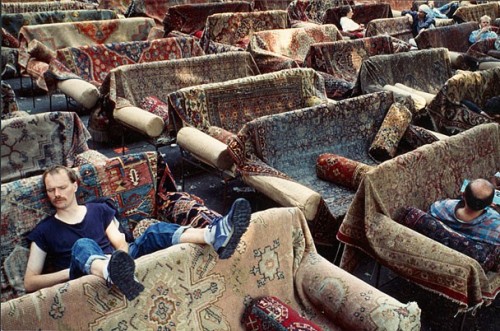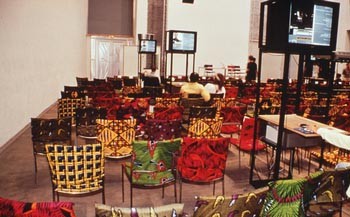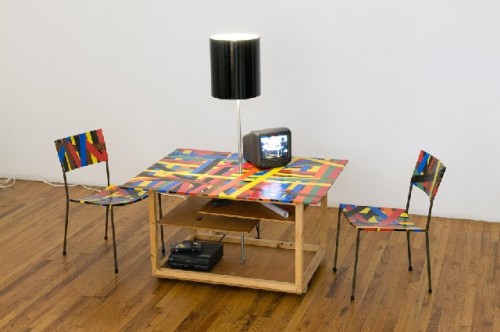Franz West at Mass MoCA and WCMA
From Actionism to the Absurd
By: Charles Giuliano - Jun 21, 2014
With the much anticipated opening of the Clark Art Institute expansion designed by Tadeo Ando there will be considerable art related travel to Northern Berkshire County.
This will also be the first full summer of the Mass MoCA building of works by the German artist Anselm Kiefer. The long term loan from the Hall Art Foundation, now augmented with sculptures by Franz West, enhances the similar Sol LeWitt building which has increased attendance over the past few years.
Taken together, and adding the Williams College Museum of Art as a buffer between these major institutions, there is now more world class art on view than visitors can absorb in just one day.
Add a visit to the Williamstown Theatre Festival with a knockout season planned by Jenny Gersten and there are compelling reasons to make a weekend of a visit to Northern Berkshire County.
The building that houses the Kiefer works is an example of efficient, minimalist, reuse architecture. The structure was erected over an abandoned retainer pool which was a part of the cooling system for the industrial complex of the former Sprague Electric campus.
The area around the Kiefer building has been meticulously manicured with a road leading to an eventual passage across the highway to the developing Heritage Park.
By itself the Kiefer building with its strident form follows function modernism is severe and imposing. Opposite to it is a large setback area surfaced with clean, bright gravel.
In this area, creating a playful dialogue with the severe and intense Kiefer installation, are several large, pink colored, funky surfaced, phallic, dildo-like bubble gum evoking sculptures by the late Viennese artist, Franz West (16 February 1947- 25 July 2012).
This amusing juxtaposition of the mordantly absorbed Kiefer and the raucous West provide a yin and yang study of the extremes of the Northern European, Goth based Germanic artistic sensibility. Deconstructing their disparate intentionality evokes the rampant romanticism and nationalism that spawned magnificent art as well as the Third Reich and the Holocaust.
As artists of the first post war generation it is essential to understand how a legacy of the defeat and shame of their parent’s generation informed their work in these quite different manifestations.
The work of Kiefer often entails meditations on German romanticism and militancy while West may be viewed as a bathetic escape from those grim realities.
They are responders to the paradigms of art with its masks of tragedy and comedy. Responding to extremes of the human condition one may laugh or cry.
The legacy of horrific circumstances informed the culture of post war Germany and Austria resulting in some of the most profound and compelling art of our time. In a range of approaches the arts responded to a Wagnerian Gotterdamerung resulting in the utter ruin of the Third Reich.
As children and young artists they grew up playing in the rubble.
In general Americans are familiar with the leading German artists: Joseph Beuys, Kiefer, Gerhard Richter,Wolf Vostell, Georg Baselitz, A. R. Penck, Group Zero, Jorg Immendorf, Martin Kippenberger, Markus Lupertz, Stephan Balkenhol, Blinky Palermo, and Sigmar Polke who is the subject of a current retrospective at the Museum of Modern Art.
The leading Austrian artists, with the possible exception of West, are relatively unknown but every bit as significant.
It is problematic to consider that although a Roman Catholic nation Austria made little or no effort to resist the Holocaust. Pope Pius XII looked the other way. In her controversial book "Eichmann in Jerusalem" Hannah Arendt is specific in revealing that a priest in the Vatican helped fleeing Nazis to secure safe passage and new identities in Latin America.
The Vienna Actionists; Günter Brus (born 27 September, 1938), Hermann Nitsch (born 29 August 1938), Otto Muehl (16 June 1925 – 26 May 2013), Rudolf Schwarzkogler (13 November 1940, Vienna – 20 June 1969, Vienna) through violent actions performed exorcisms that conflated the vestments and rituals of the Church with the carnage of the Holocaust.
West, who was a decade older on average than the Vienna Actionists, studied art relatively late when the ultra conservative Austria and incrementally more liberal Vienna were reacting to the renegade works of the young Turks.
In 1965 Brus wearing a white suit, his head painted white, with a black line drawn over his head and down his body casually walked through Vienna. This lead to his arrest. Later Muehl was convicted of child sexual abuse in his commune and served a long prison sentence. Shwarzkogler, whose work evokes self mutilation, is alleged to have cut off his penis in a performance work. The artist jumped to his death during an acid trip.
During one of several visits to Vienna I spent a day at the suburban schloss of Nitsch with the attorney/ artist/ collector Gerald Hirn. I wrote an essay for the catalogue of his exhibition at Boston's Levinson Kane Gallery. We explored the extensive painting studios where initially Nitsch had created works using buckets of blood collected from a butcher. When working Nitsch wears loose smocks on which he wipes excess paint. These are then sold as works of art.
Over lunch Nitsch explained to me that all of the animals used in his multi-day actions had been previously slaughtered by professional butchers. There were no "sacrifices" in the elaborate rituals set to his musical compositions. Guests for these actions feasted on the animals used in the art works and slept in the barns of the farm/ estate.
By the time of my visit the Actionists were successful and acclaimed. When Vienna's Museum of Modern Art was created in the former Habsburg stables the lower level was devoted to a permanent display of the Actionists.
In Vienna of several occasions I visited a number of studios including that of the surrealist sculptor Bruno Gironcoli (27 September 1936 – 19 February 2010). The studio was so dense with plaster works of organic and industrial forms that we sat on a fire escape for wine and cake.
I felt that Gironcoli was one of the most interesting and least know of the Vienna masters. He was enormously important to the younger artists who were impressed that I had met with him. Later I lobbied to review his rare New York exhibition of works on paper for Art News.
It is significant that West studied with Gironcoli who pursued a more formalist approach providing an alternative to a focus on history and sociology. Compared to other artists of his generation in Vienna Gironcoli was more Apollonian than their Dionysian penchant. His work was so unique that it provided no easy formula for curators and critics.
When making didactic dialogues about post holocaust movements it is inconvenient to include the exceptions that undermine a cohesive critical analysis. Of course it is deviations like Gironcoli, and through him, West, that prove the rule.
The impact and cultural legacy of the Holocaust, genocides, slavery, colonialism, sexism, weapons of mass destruction are so daunting that they render us mute and impotent. It takes enormous effort to overcome the weight of remorse and resultant inaction.
"The critique of culture is confronted with the last stage in the dialectic of culture and barbarism: to write a poem after Auschwitz is barbaric, and that corrodes also the knowledge which expresses why it has become impossible to write poetry today." Theodore W. Adorno
Of course, undaunted by our horrific humanistic legacy, there is a plethora of art and poetry. Consider the proliferation of nice art all the more offensive for its lack of moral compass. It has morphed into an industry of cultural banality.
One can sense the pressure on the young West when he opted to laugh rather than cry.
Encountering his playful, messy, absurdist, lumpy, plaster sculpture, plain or polychromed in Vienna or visits to versions of documenta, I didn’t know what to make of them. They seemed simply awful by any definition.
Curators routinely included West in their biennial and museum projects. There was just no way to escape his work.
Two years ago we encountered his bright, colorful, feces/ sausage like sculptures at the Baltimore Museum of Art. The museum hosted the first American retrospective of the work of West. They were meant to be sat upon and we did playfully. It was fun but annoyed me while walking through Baltimore's great Cone collection and its amazing depth in Matisse including the iconic "Blue Nude" from 1907.
Another of the West tropes was to create furniture from welded rods with colorfully upholstered seats. He fabricated metal “couches” draped with oriental carpets. There were large installations of these functional works at documenta including seating in the hall during “One Hundred Days” with its daily programming.
Most of my encounters with West have been annoying.
Including a visit to the Williams College Museum of Art which is offering a companion overview for the MoCA installation.
There is a generous selection of the slap dash painted over collages. While the works are deliberately crude and accessible, visual one liners, there is little impetus to linger and probe. There are a number of amorphous colored sculptures on pedestals, suspended as ersatz lighting fixtures, or on the floor.
In theatre of the absurd there are many circles as we descend into the hell of irony.
Frankly, I prefer to take that journey with Dieter Roth (Swiss, April 21, 1930 – June 5, 1998) whom I regard as a far more inventive exemplar of the absurd. His 2004 MoMA retrospective was astonishing for its depth and invention. Compared to which West seems aesthetically limited. West had good ideas but didn’t push them hard enough.
Looking at the large scale sculptures at MoCA the colors seemed faded. I recall them as brighter and more intense. Like the one installed at the landing of the stairs at WCMA.
For most visitors to MoCA and WCMA the likely responses will range from amused to confused.
A perk of living near these museums is the opportunity to return and absorb work over time. There are niche aspects of the oeuvre to explore. Particularly the “wearable” sculptures. At WCMA there is an evocative photo of the nude artist wearing a plaster sculpture as a kind of skirt concealing his privates.
Curious about the density of the large outdoor pieces which look soft and puffy I poked one gently. Thinking to be alone I was surprised by a guard at a considerable distance who yelled “Don’t touch the art.”
Until then it hadn’t occurred to me that it was, you know, art.
That term is applied so loosely nowadays.
The work of West often seems as overblown as his enormous silly, pink sculptures.

